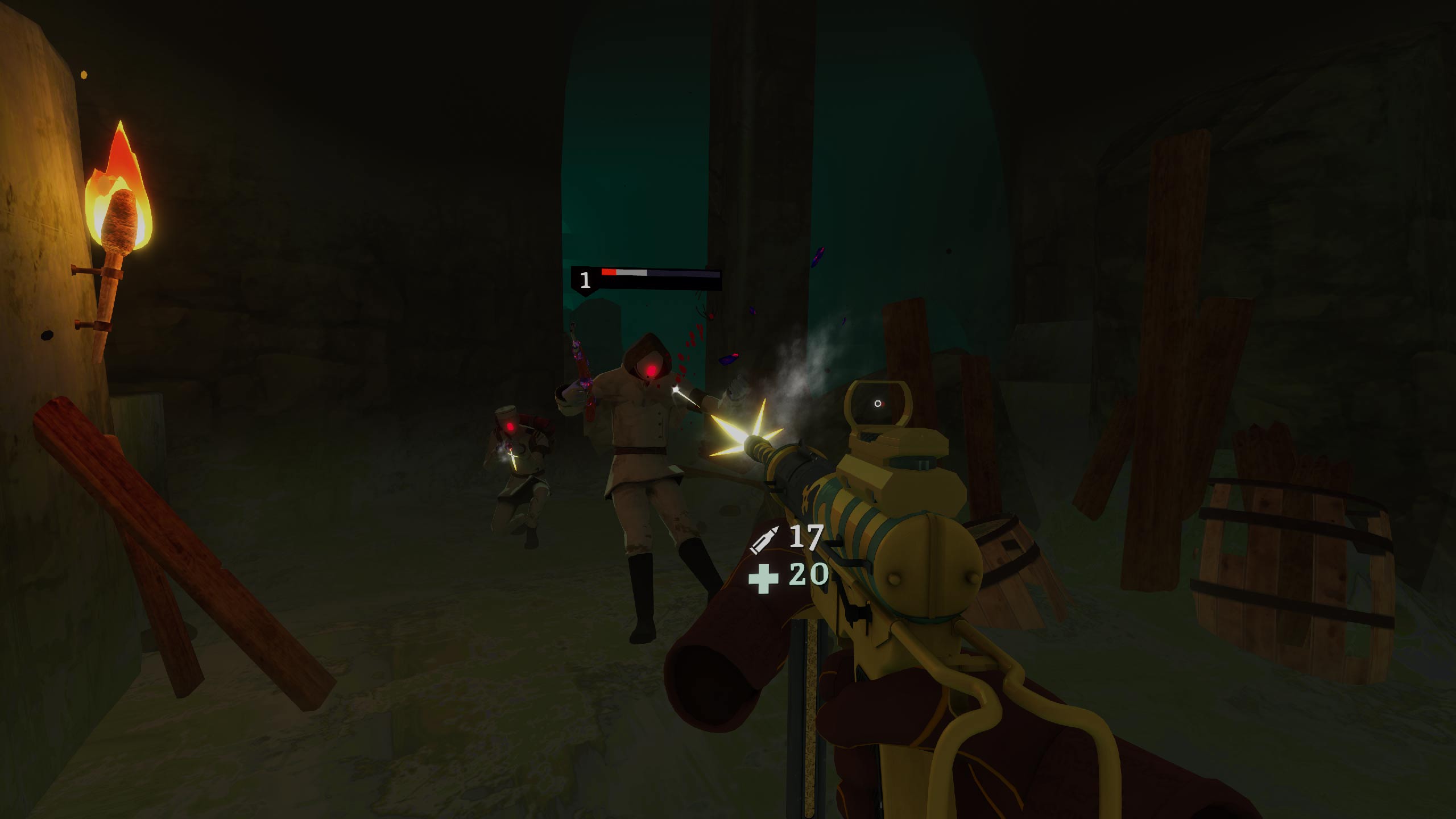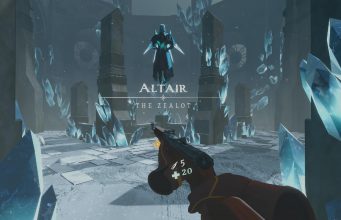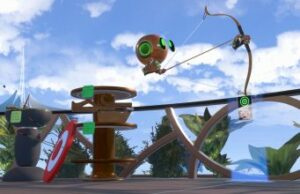The Light Brigade is a roguelike shooter that I would mostly describe as a spiritual successor to In Death: Unchained, the critically acclaimed bowshooter from Sólfar Studios and Superbright. While at times a little less visually polished than In Death, the game’s variety of upgrades and array of WWII-era weaponry gives it a definite Wolfenstein bend that fans of the shooter genre will instantly be able to click into.
Available On: SteamVR, PSVR 2 & PSVR, Quest 2
Release Date: February 22nd, 2023
Price: $25
Developer: Funktronic Labs
Reviewed On: Quest 2 (native), Quest 2 via PC Link
Gameplay
There’s a definite story in The Light Brigade, although past the opening scene I really couldn’t remember what was actually at stake up until I completed my first full run. The game doesn’t chock too much story your way (or over tutorialize either), leaving you to just fight the bad guys while you save the culty good guys. Really, all you need to know is the demon-eyed, Nazi-adjacent baddies aren’t friendly, and the hellish fantasy-scape composed of discrete and sequentially connected levels must be cleared out and scoured methodically for loot.
It’s just pure action-adventure fun, as the meat of the game presents plenty of interesting upgrade paths which not only prolong your current run, but importantly give you enough reason to come back for more upon your inevitable death.
The Light Brigade feels forgiving enough to really keep you grinding for that next gun mod or class upgrade too, which gives you access to cooler-looking and more powerful versions of each weapon. Meanwhile, the game is busy serving up a good difficulty ramp that means your next run may not be necessarily easier despite progressively wider access to guns, magic, and upgrades.
That’s all well and good, but what about the guns? Thankfully, The Light Brigade really gets its WWII weaponry right, providing physics-based rifles and pistols which each come with their own immersive reloading mechanics. Loading and shooting the M3 submachine gun requires you to grab its stick-style magazine and chunk back the charging handle to chamber the first round, while shooting a K98 rifle is totally different, making you jam down stripper clips to feed the bolt-action rifle.
Practically speaking, sticking to a single class isn’t a terrible strategy as you get your grips with the game, as you’re probably looking to maximize your rank and unlock permanent upgrades since they don’t sync across classes.
In practice though, you’ll probably do a fair amount of class hopping once you progressively unlock the next available class, taking you from the starter Rifleman class with its semi-automatic Gewehr 43 rifle all the way through the other iconic WWII weapon-wielding classes the game has to offer, including the Sturmgewehr 44 submachine gun, the M3 submachine gun (aka ‘Grease Gun’), the powerful K98 battle rifle, and even a class that has dualie Colt 1911s for some John Wick-style madness.
As for enemies, the world’s baddies come in a pretty standard range, starting with your standard goons, which include shooters and archers. You’ll eventually come across shielded goons, tanks, and versions that fly, snipe, and lob bombs too. There always seems to be a new type added to the mix after each attempt though, so there may be more I don’t know about.
By this point, I’ve already made it through one full run, although that was after many (many) failed attempts spanning over about eight hours of gameplay—another thing that makes The Light Brigade a little more generous than In Death, which is probably there to keep it a little more of a fast-paced experience.
Levels are fairly linear, although there’s plenty of cover to hide behind as you make your forward march. That also means finding the remaining enemies can sometimes be tough, but thankfully prayer actually works in this universe, helping you to locate remaining loot and baddies. Enemies are revealed by showing you small red dots while chests are yellow.
And once you’ve finally cleared out the level’s baddies—you get a big ‘LEVEL CLEAR’ popup—then it’s time to scour for loot, oftentimes hidden in breakable vases and chests.
Here, you can find gold to buy consumables, weapon upgrades like scopes and magical trinkets, souls which increase your rank level, and the occasional key, which can open locked chests.
Mostly though, you’re looking for souls, the whispy white things that you’ll earn after killing enemies or finding soul containers. There’s also cards that give each run a unique set of possible upgrades. Choose one of three presented to you, and you might just significantly increase the damage you can deal, injecting a bit of luck into each run’s loot haul.
It’s not all WWII guns and demon Nazis though. The world is also magic-based, giving you upgradeable magic wands that can do things like provide shields, shoot fireballs, etc.
All of this effectively combines to offer a good selection of gameplay styles, letting you attack the world as you want.
Still, I have my gripes with The Light Brigade, the worst offender being its inventory holters attached to your belt. In practice, this makes reloading quickly and consistently an absolute pain. Instead of having a fixed area where you can reliably train muscle memory, shifting your body around physically or virtually with any of the artificial locomotion schemes has a funny way of shifting the belt holster around your waist in weird an unpredictable ways.
I get it: you should be covering and assessing your ammo situation at all times so you don’t run dry during critical moments, but having to crane your neck down every few seconds to make sure your hand is actually hovering over the right area is decidedly a dull spot on an otherwise shining example of great VR gaming.
I’m still working on getting the last remaining achievements and consistently beating the first boss as I attempt my successive runs. Considering the array of gun upgrades and magical weapons to explore, it’s safe to say I’m nowhere personally finished with this well-crafted roguelike. I won’t talk too much about bosses, although they are hard, and offer up unique bossy ways of dealing out damage—pretty much what’d you expect from a fantasy shooter, i.e., they can shield, do magic, and surprise you throughout the encounter, so they aren’t just glorified bullet sponges.
Immersion
I get it: The Light Brigade is all about bringing light back to a dark and corrupted world, but it is very dark. At times, I felt it offered less visual contrast than Quest 2’s LCD displays can rightly handle, making some levels appear more muddy and generally more difficult to resolve visually.
Road to VR has a PSVR 2 in hand, although I don’t personally. I have had a chance to preview the headset though, and its OLED displays with HDR will undoubtedly be more capable of serving up better visual contrast. Still, if you’re playing on Quest 2 natively, or any number of PC VR headset running the Steam version, you may find later bits of the game very difficult to resolve visually.

Were it not for the beady red eyes that shine in the darkness, enemies would be maybe too difficult to make out in the ever-present fog of war. Still, it’s a fairly muddy palette any way you slice it; level design and variety as you move forward are always interesting at least.
The star of the show though is inevitably the game’s weapons, which provide subtle articulations that really make it feel more of a realistic experience. For example, you can cycle a magazine’s worth of cartridges just because you mechanically can. You don’t need to, but the fact that The Light Brigade’s guns functionally work like real guns means the player should be able to if they want to. See my magazine empty as I eject unfired bullets:
Another immersive touch is the gun’s physical weight, which affects how you hold and steady it. A pistol requires a steadier hand because it’s lighter and easier to swing around, while a rifle is more forgiving with movement since the game registers as it being substantially heavier in the player’s hand. Suitably, some guns let you steady with your non-dominant hand, providing discrete attach points to do so.
I was hoping for some amount of melee, although there’s none present to speak of, meaning if your gun runs dry, you better find cover and reload, or pull out your trusty sidearm.
A note one positional audio: enemies provide good spatial audio cues for their relative locations—something important once levels start getting more claustrophobic, like in the sewers.
Comfort
The Light Brigade has a good swath of standard comfort options which, include optional smooth or snap-turn, and smooth locomotion or teleport.
Playing seated is possible, and the game comes with a seated mode, although it’s not advisable since your belt holster may be awkwardly positioned at any time, making standing play the least encumbering way to interface.
The Light Brigade’ Comfort Settings – February 15th, 2023 |
|
Turning |
|
| Artificial turning | ✔ |
| Snap-turn | ✔ |
| Quick-turn | ✖ |
| Smooth-turn | ✔ |
Movement |
|
| Artificial movement | ✔ |
| Teleport-move | ✔ |
| Dash-move | ✖ |
| Smooth-move | ✔ |
| Blinders | ✔ |
| Head-based | ✔ |
| Controller-based | ✔ |
| Swappable movement hand | ✖ |
Posture |
|
| Standing mode | ✔ |
| Seated mode | ✔ |
| Artificial crouch | ✖ |
| Real crouch | ✔ |
Accessibility |
|
| Subtitles | ✔ |
| Languages |
English, Portuguese, Spanish, Italian, German, French, Russian, Chinese (Simplified), Chinese (Traditional) , Korean, Japanese |
| Dialogue audio | ✔ |
| Languages | English |
| Adjustable difficulty | ✖ |
| Two hands required | ✔ |
| Real crouch required | ✖ |
| Hearing required | ✖ |
| Adjustable player height | ✖ |



